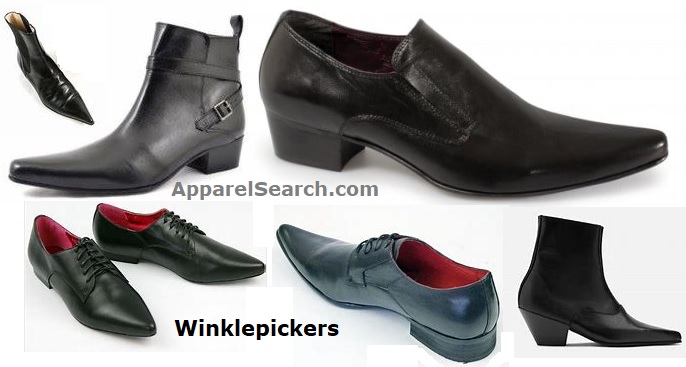What is a winklepicker? In summary, they are very long pointy shoes. Winklepickers, or winkle pickers, are a style of shoe or boot worn from the 1950s onward by British rock and roll fans. A Chelsea Boot style (elastic-sided with a two-inch, and later as much as two-and-one-half-inch, Cuban heel) was notably worn by the Beatles but although it had a pointed toe, was not truly considered to be a winklepicker.
How did these shoes obtain their odd sounding name?
The extremely pointed toe was called the winkle picker because in England periwinkle snails, or winkles, are a popular seaside snack which is eaten using a pin or other pointed object to extract the soft parts out of the coiled shell carefully, hence the phrase: "to winkle something out", and based on that, winklepickers became a humorous name for shoes with a very pointed tip.
Which historical footwear inspired winklepicker footwear in the more recent past?
Winklepicker shoes were inspired by the Poulaines.
- Crakows or crackowes were a style of shoes with extremely long toes very popular in the 15th century. They were so named because the style was thought to have originated in Kraków, then the capital of Poland. They are also sometimes known as poulaines or pikes, though the term poulaine, as in souliers a la poulaine, "shoes in the Polish fashion", referred to the long pointed beak of the shoe, not the shoe itself.
The feature that gives both the boot and shoe their name is the very sharp and long pointed toe, reminiscent of medieval footwear.
Other countries had other humorous names, e.g. in Norway and Sweden they were called myggjagere/myggjagare, literally "Mosquito hunter". They are still popular in the raggare and rockabilly subcultures. In some parts of the U.S. they are called "roach stompers."
1950's: Winklepickers with stiletto heels for women swept the UK in the late 1950s, and at one stage, the High Street versions were commonly worn by a large part of the adult female populace of the UK. They were often manufactured in Italy, but the handmade versions, notably those from Stan's Shoes of Battersea, were the most extreme, if somewhat bulky-looking at the toe compared with the Italian styles.
1960's: The original 1960s winklepicker stilettos were similar to the long, pointed toe that has been fashionable on women's shoes and boots in Europe of late. The long, sharp toe was always teamed with a stiletto heel (or spike heel), which, as today, could be as low as one-and-a-half inches or as high as five inches, though most were in the three- to four-inch range. The stiletto heels on the original 1960s styles were, however, much more curved in at the rear (also sometimes sharply waisted and slightly flared out at the top piece) than most of the recent pointy-toed fashion shoes, which often have straighter, thicker, more set-back heels, rather at odds with the look of the pointed toe. In most cases, too, the modern shoe toes lack the length of the true 1960s winklepicker and bear more resemblance to the less pointed mass-produced versions of the era.

